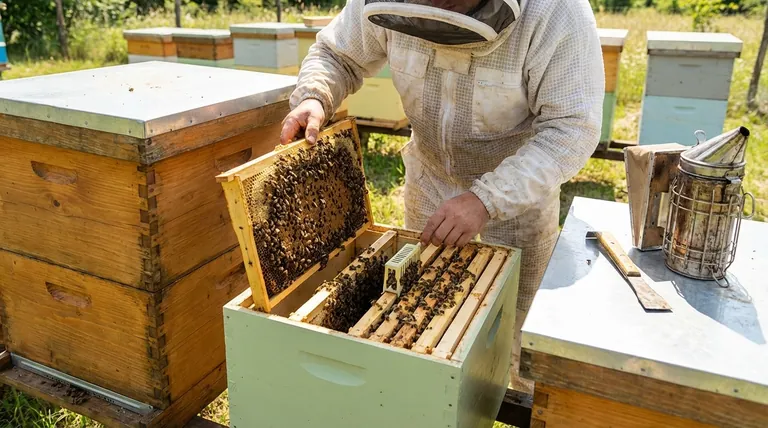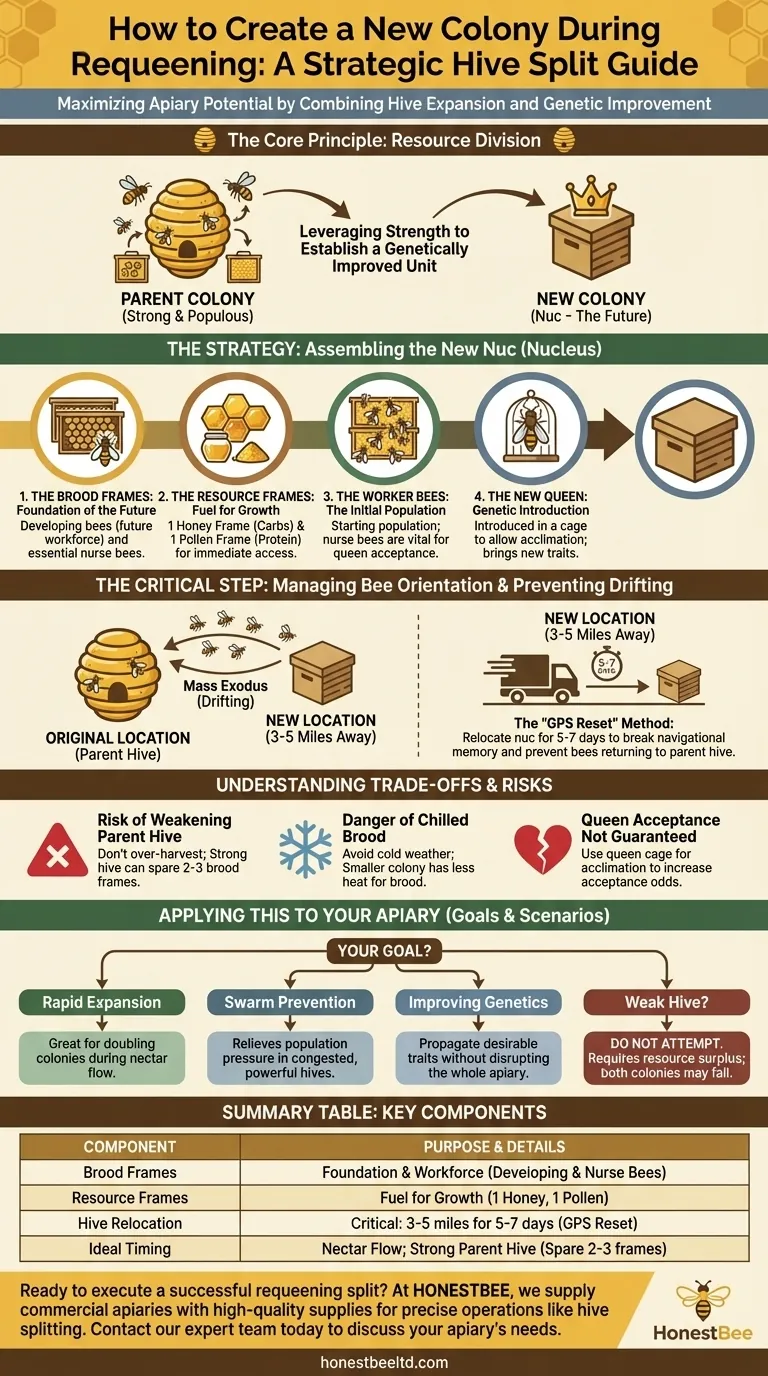To create a new colony while requeening, you perform a specialized hive split. This involves removing select frames of brood, resources, and bees from the strong parent colony, placing them into a new hive box with a new queen, and moving that new hive to a different location to ensure its survival. The old queen is left behind in the original, now slightly smaller, parent hive.
The core principle is resource division: you are leveraging the strength of a populous colony to establish a new, genetically improved one. The success of this operation hinges on preventing the worker bees from the new hive from returning to their original home, a problem solved by temporarily relocating the new colony.

The Strategy: Combining Hive Expansion and Improvement
This technique is a highly efficient beekeeping practice. It allows you to accomplish two major goals—increasing your number of hives and introducing new genetics—in a single, well-timed operation.
Assembling the New Colony (The "Nuc")
The new hive, often started in a smaller "nucleus" or "nuc" box, must be a balanced, self-sufficient unit from day one. You are creating a miniature version of a full-sized colony.
The Brood Frames: Foundation of the Future
You will transfer frames containing developing bees, known as brood. These frames provide the new colony's future workforce. They are also covered in nurse bees, which are essential for caring for the brood and attending to the new queen.
The Resource Frames: Fuel for Growth
A new colony needs immediate access to food. Include at least one frame of honey for carbohydrates and a frame with pollen for protein. This ensures the colony can feed itself while it becomes established and before its foragers are fully operational.
The Worker Bees: The Initial Population
The bees clinging to the frames you move are the starting population of your new colony. The nurse bees on the brood frames are particularly vital, as they are less likely to fly back to the parent hive and will readily accept the new queen.
The Critical Step: Managing Bee Orientation
A bee’s internal "GPS" is precisely locked to its home hive's location. If you simply place the new hive next to the old one, the foraging bees will abandon the new colony and fly back to their original home, causing the new hive to collapse.
Why Moving the Hive is Non-Negotiable
This mass exodus of foragers is called drifting. It strips the new colony of its workforce, leaving the new queen and nurse bees with insufficient resources and population to survive. You must break the bees' old orientation.
The "GPS Reset" Method
The most reliable method is to move the newly created nuc to a different location, ideally at least 3-5 miles away. After keeping it there for a minimum of 5-7 days, the bees' navigational memory will be reset. When you bring the hive back to your primary bee yard, they will re-orient to their new box as their permanent home.
Understanding the Trade-offs and Risks
While efficient, this method requires careful judgment and is not without its challenges. Understanding the potential downsides is key to a successful outcome.
Risk of Weakening the Parent Hive
Be conservative when removing resources. Taking too many frames of brood or bees can severely set back the original colony, making it vulnerable and unproductive for a period. A strong hive can typically spare 2-3 frames of brood without significant impact.
Danger of Chilled Brood
The new, smaller colony has fewer bees to generate heat and keep the brood warm. Do not attempt this split in cold weather, as the brood could chill and die, delivering a fatal blow to your new hive.
Queen Acceptance is Not Guaranteed
As with any requeening effort, there is always a chance the bees in the new colony will reject and kill the new queen. Introducing her in a queen cage gives the bees time to acclimate to her pheromones, increasing the odds of acceptance.
Applying This to Your Apiary
Your specific goal will determine how and when you use this technique.
- If your primary focus is rapid expansion: This is an excellent method for turning one strong colony into two productive ones during a nectar flow.
- If your primary focus is swarm prevention: Performing this split on a congested, powerful hive can relieve population pressure, satisfying the bees' urge to swarm while giving you a valuable new colony.
- If your primary focus is improving genetics: This technique allows you to propagate desirable traits (like gentleness or mite resistance) from a new queen into a new colony without disrupting your entire apiary.
- If you are dealing with a weak hive: Do not attempt to split it. This method relies on a surplus of resources that a weak colony simply does not have; trying to do so will likely cause both hives to fail.
Executing this maneuver successfully is a mark of skillful and proactive beekeeping.
Summary Table:
| Key Component | Purpose & Details |
|---|---|
| Brood Frames | Foundation of the new colony; provides future workforce (developing bees) and essential nurse bees. |
| Resource Frames | Fuel for growth; includes 1 frame of honey (carbohydrates) and 1 frame of pollen (protein). |
| Hive Relocation | Critical for success; move the new nuc 3-5 miles away for 5-7 days to reset bee orientation and prevent drifting. |
| Ideal Timing | Perform during a nectar flow; requires a strong parent hive that can spare 2-3 frames of brood without being weakened. |
Ready to execute a successful requeening split and expand your apiary with confidence?
At HONESTBEE, we supply commercial apiaries and beekeeping equipment distributors with the high-quality, durable supplies needed for precise operations like hive splitting. From nucleus boxes and frames to essential protective gear, our wholesale-focused operations ensure you have the right tools for sustainable colony growth.
Contact our expert team today to discuss your apiary's needs and discover how our equipment can support your success in hive management and expansion.
Visual Guide

Related Products
- Jenter Queen Rearing Kit Complete Set for Bee Breeding
- Nicot Queen Rearing Kit for Beekeeping and Grafting in Nicot System
- No Grafting Queen Rearing Kit: System for Royal Jelly Production and Queen Rearing
- Retractable Chinese Queen Rearing Grafting Tools Equipment
- Plastic Chinese Queen Grafting Tool for Bee Queen Rearing
People Also Ask
- What were the size differences among queens reared from worker larvae? Maternal Origin Determines Queen Size
- What genetic pathways differ in QE-queens? Unlocking the Master Controls of Queen Bee Biology
- What are the stages involved in queen raising? A Guide to Controlled, High-Quality Queen Production
- Why is raising queens beneficial for beekeepers? Gain Control Over Genetics and Costs
- What happens to the colony population during the 5–6 weeks after a new queen emerges? Understand the Natural Dip and Rebound



















